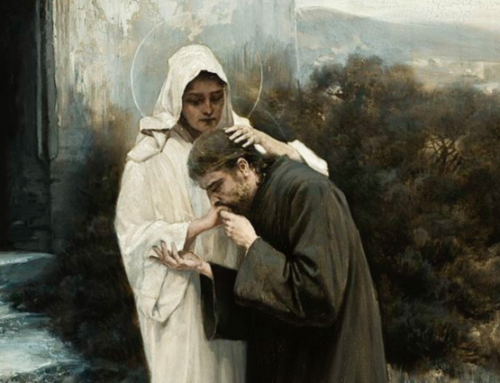In the character of Gollum, J.R.R. Tolkien perfectly portrays a being distorted by depraved desire and dominated by a magnificently evil obsession. However, as I was re-reading the “The Lord of the Rings,” I began to wonder about the origins of this pathetic creature.
For summertime reading I have returned to an old favorite: the glorious hard back, complete version of J.R.R. Tolkien’s masterpiece The Lord of the Rings.
One of the greatest characters in Tolkien’s cast of heroes is the frog-like hobbit Sméagol, otherwise known as Gollum. With marvelous psychological insights, Tolkien perfectly portrays a character distorted by depraved desire and dominated by a magnificently evil obsession.
As I was re-reading, I began to wonder about the origins of Gollum. Did he simply spring from Tolkien’s imagination, or was there some spark that gave the creature life in Tolkien’s mind? I remembered the Jewish legend of The Golem and wondered if there could be a link.
The Golem, according to Jewish folk tales, is a humanoid creature which a rabbi, versed in Cabalistic lore, creates from clay. The monster serves as a slave to his master until he is “de-programmed” and falls back into dust. Was the legend of the Golem an inspiration for Tolkien’s creation? I wondered. I couldn’t find any evidence of a historical connection. If there was a Jewish link in Tolkien’s thoughts at all, it was a scrap of evidence from one of his letters that he thought of the dwarves as Jew-like, and there did not seem to be any link other than Gollum’s name to the Jewish monster Golem.
When I mused about this publicly online, a commenter on Twitter pointed out that, “There’s a cave in County Clare, Ireland named Poll na gColm or Pollnagollum which may have given Tolkien’s cave-dwelling creature its name.” Now, there was an intriguing clue. Tolkien was very fond of the Welsh language and had traveled in Ireland a fair bit. Did he hear the language and take the hint? Did he create his cave dwelling monster from the name of the cavern in County Clare? Again, the linguistic similarity is interesting, but is there anything to it?
I think not. Instead, Tolkien himself explained that Gollum was given his nickname by his Stoor-hobbit relatives due to his muttering and complaining and the gulping, guttural sounds he made when they persecuted him for his selfish, grasping thievery.
As for Sméagol, Tolkien explains in Guide to the Names in Lord of the Rings, “Sméagol’s name is derived from Old English sméah, an adjective meaning “creeping in, penetrating.” This word is related to the word smial, which was applied by the Anglo-Saxons to Cain, who slew his brother Abel, establishing a connotative link between Sméagol, who murdered his cousin Deagol to steal the ring.
Within the linguistic world of Middle Earth Sméagol is the translation of a Westron name Trahald, the meaning of which was “burrowing, worming in” or “apt to creep into a hole”. Westron, (for those not so steeped in Tolkien lore) is the language of the Dunadain—the rangers and princes of the Northern realm. In both Westron and Old English, Sméagol’s name is related to the dragon Smaug’s.
The question of Gollum’s origins must include not only how he got his name in Tolkien’s legendarium, but also how he became what he was. When I was studying film writing, the tutor explained, “If you want to create a convincing villain you must understand his backstory and sympathize. You must understand why he really believes himself to be good and that the evil he does he perceives as a good.” This was brought home to me when I was involved in prison work. I asked men, who were among a group of convicts preparing for release, what their crime was and whether they considered it to be good at the time.”
One man who was jailed for burglary said frankly, “I knew breaking into old ladies’ houses to rob them was bad, but the feeling the drugs gave me was good so, yeah, you’re right. I reckoned what I was doing was against the law, but for me, it was good.”
Gollum incarnates this same paradox. Sméagol desires the ring not out of evil intent, but because he desires power—power to obtain that which seems good in his eyes. It is that grasping for power which corrupts him and distorts his whole being changing him into the loathsome Gollum.
So, as “Gollum” is a linguistic distortion of “Sméagol” the character is a monstrous distortion of an originally good hobbit. Sméagol was given the nickname by his relatives because of his gulping, muttering—the gulping muttering was a manifestation of the distorting power of evil already at work in Smeagol’s mind, and this distorting power of evil plays out as one of the most riveting themes in Tolkien’s great saga.
That’s where Gollum comes from, and any connections to the monster of Cabalistic folklore, or a cave in Ireland, must be purely co-incidental.
The Imaginative Conservative applies the principle of appreciation to the discussion of culture and politics—we approach dialogue with magnanimity rather than with mere civility. Will you help us remain a refreshing oasis in the increasingly contentious arena of modern discourse? Please consider donating now.
The featured image is a picture of the giant Gollum sculpture at Wellington Airport in Wellington, New Zealand. It is in the the public domain, courtesy of Wikimedia Commons.








Leave A Comment